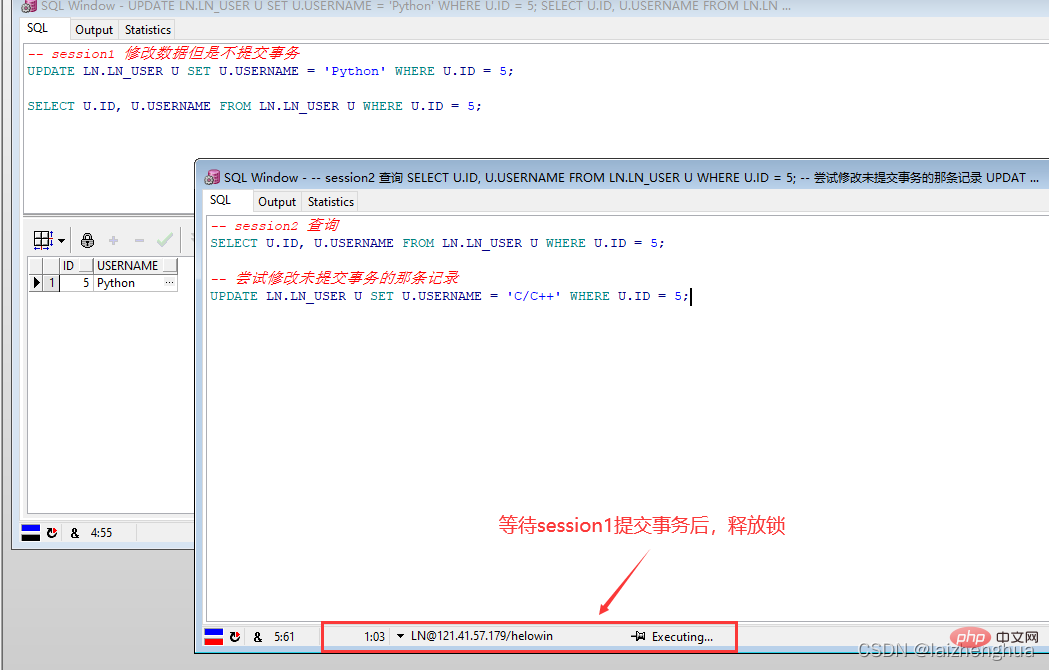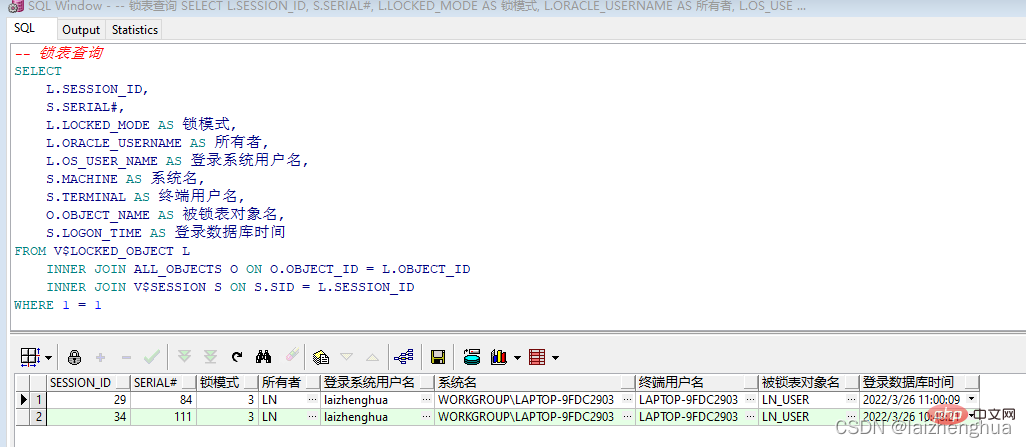Detailed graphic and text explanation of Oracle lock table solutions
This article brings you relevant knowledge about Oracle. When developing Oracle database, we often encounter Oracle data tables that are frequently operated, and Oracle lock tables will appear. Here is an introduction to you I have found relevant information about Oracle lock table solutions. I hope it will be helpful to everyone.

Recommended tutorial: "Oracle Video Tutorial"
I believe everyone is familiar with table locks or lock timeouts, which often occur in DML statement, the reason is the exclusive locking mechanism of the database. When a DML statement is executed, the table or row data is locked until the transaction is committed or rolled back or the current session is forcibly ended.
For our application system, table locking will most likely occur where SQL execution is slow and there is no timeout (a SQL has been unsuccessfully executed for some reason (the Spoon tool does data extraction and push) and has been Do not release resources) Therefore, it is particularly important to write efficient SQL! There are also other situations where table locking may occur, which is a high concurrency scenario. The problem caused by high concurrency is that Spring transactions will cause database transactions to be uncommitted and cause deadlock (the current transaction is waiting for other transactions to release lock resources)! Thus throwing the exception java.sql.SQLException: Lock wait timeout exceeded;.
So how to solve the lock table or lock timeout? The temporary solution is to find out the table or statement that is competing for the lock resource, directly end the current session or session, and force the lock resource to be released. For example
The solution is as follows:
1. Session1 modifies a certain piece of data but does not submit the transaction, and session2 queries the record of the uncommitted transaction

2. Session2 tries to modify

We can see that the record of modifying uncommitted transactions will be in a waiting state until the other party releases the lock resource or forcibly closes session1. This also shows that Oracle has achieved row-level locks!
This is just a simple simulation of the table lock situation. You can see at a glance that it is the table lock caused by session1. When encountering this situation in actual development, SQL is generally used to directly find out the tables or statements that compete for lock resources and then forcefully release the resources! !
3. Session3 queries the tables or statements that compete for resources and forces the resources to be released.
-- 查询未提交事务的session信息,注意执行以下SQL,用户需要有DBA权限才行
SELECT
L.SESSION_ID,
S.SERIAL#,
L.LOCKED_MODE AS 锁模式,
L.ORACLE_USERNAME AS 所有者,
L.OS_USER_NAME AS 登录系统用户名,
S.MACHINE AS 系统名,
S.TERMINAL AS 终端用户名,
O.OBJECT_NAME AS 被锁表对象名,
S.LOGON_TIME AS 登录数据库时间
FROM V$LOCKED_OBJECT L
INNER JOIN ALL_OBJECTS O ON O.OBJECT_ID = L.OBJECT_ID
INNER JOIN V$SESSION S ON S.SID = L.SESSION_ID
WHERE 1 = 1The query results are as follows

forces the release of resources for us. Only the first two fields are useful. For example,
-- 强制 结束/kill 锁表会话语法 ALTER SYSTEM KILL SESSION 'SESSION_ID, SERIAL#'; -- 强制杀死session1,让session2可以修改id=5的那条记录 ALTER SYSTEM KILL SESSION '34, 111';
After forcibly killing session1, pay attention to the execution of session2! We will find that the waiting of session2 will be terminated and executed immediately! I believe everyone has a doubt, session_id is 29 and 34, how to determine whether they belong to session1 or session2, and ensure that session1 is killed so that session2 can successfully execute the DML statement?
In fact, it is also very simple. The judgment here The method is that session1 performs the update but does not submit the transaction. You can first use the above SQL to query the session information of the uncommitted transaction. At this time, the information found is the information of session1.
Recommended tutorial: "Oracle Video Tutorial"
The above is the detailed content of Detailed graphic and text explanation of Oracle lock table solutions. For more information, please follow other related articles on the PHP Chinese website!

Hot AI Tools

Undresser.AI Undress
AI-powered app for creating realistic nude photos

AI Clothes Remover
Online AI tool for removing clothes from photos.

Undress AI Tool
Undress images for free

Clothoff.io
AI clothes remover

Video Face Swap
Swap faces in any video effortlessly with our completely free AI face swap tool!

Hot Article

Hot Tools

Notepad++7.3.1
Easy-to-use and free code editor

SublimeText3 Chinese version
Chinese version, very easy to use

Zend Studio 13.0.1
Powerful PHP integrated development environment

Dreamweaver CS6
Visual web development tools

SublimeText3 Mac version
God-level code editing software (SublimeText3)

Hot Topics
 1668
1668
 14
14
 1427
1427
 52
52
 1329
1329
 25
25
 1273
1273
 29
29
 1256
1256
 24
24
 What to do if the oracle can't be opened
Apr 11, 2025 pm 10:06 PM
What to do if the oracle can't be opened
Apr 11, 2025 pm 10:06 PM
Solutions to Oracle cannot be opened include: 1. Start the database service; 2. Start the listener; 3. Check port conflicts; 4. Set environment variables correctly; 5. Make sure the firewall or antivirus software does not block the connection; 6. Check whether the server is closed; 7. Use RMAN to recover corrupt files; 8. Check whether the TNS service name is correct; 9. Check network connection; 10. Reinstall Oracle software.
 How to solve the problem of closing oracle cursor
Apr 11, 2025 pm 10:18 PM
How to solve the problem of closing oracle cursor
Apr 11, 2025 pm 10:18 PM
The method to solve the Oracle cursor closure problem includes: explicitly closing the cursor using the CLOSE statement. Declare the cursor in the FOR UPDATE clause so that it automatically closes after the scope is ended. Declare the cursor in the USING clause so that it automatically closes when the associated PL/SQL variable is closed. Use exception handling to ensure that the cursor is closed in any exception situation. Use the connection pool to automatically close the cursor. Disable automatic submission and delay cursor closing.
 How to create cursors in oracle loop
Apr 12, 2025 am 06:18 AM
How to create cursors in oracle loop
Apr 12, 2025 am 06:18 AM
In Oracle, the FOR LOOP loop can create cursors dynamically. The steps are: 1. Define the cursor type; 2. Create the loop; 3. Create the cursor dynamically; 4. Execute the cursor; 5. Close the cursor. Example: A cursor can be created cycle-by-circuit to display the names and salaries of the top 10 employees.
 How to export oracle view
Apr 12, 2025 am 06:15 AM
How to export oracle view
Apr 12, 2025 am 06:15 AM
Oracle views can be exported through the EXP utility: Log in to the Oracle database. Start the EXP utility, specifying the view name and export directory. Enter export parameters, including target mode, file format, and tablespace. Start exporting. Verify the export using the impdp utility.
 What to do if the oracle log is full
Apr 12, 2025 am 06:09 AM
What to do if the oracle log is full
Apr 12, 2025 am 06:09 AM
When Oracle log files are full, the following solutions can be adopted: 1) Clean old log files; 2) Increase the log file size; 3) Increase the log file group; 4) Set up automatic log management; 5) Reinitialize the database. Before implementing any solution, it is recommended to back up the database to prevent data loss.
 Oracle's Role in the Business World
Apr 23, 2025 am 12:01 AM
Oracle's Role in the Business World
Apr 23, 2025 am 12:01 AM
Oracle is not only a database company, but also a leader in cloud computing and ERP systems. 1. Oracle provides comprehensive solutions from database to cloud services and ERP systems. 2. OracleCloud challenges AWS and Azure, providing IaaS, PaaS and SaaS services. 3. Oracle's ERP systems such as E-BusinessSuite and FusionApplications help enterprises optimize operations.
 What steps are required to configure CentOS in HDFS
Apr 14, 2025 pm 06:42 PM
What steps are required to configure CentOS in HDFS
Apr 14, 2025 pm 06:42 PM
Building a Hadoop Distributed File System (HDFS) on a CentOS system requires multiple steps. This article provides a brief configuration guide. 1. Prepare to install JDK in the early stage: Install JavaDevelopmentKit (JDK) on all nodes, and the version must be compatible with Hadoop. The installation package can be downloaded from the Oracle official website. Environment variable configuration: Edit /etc/profile file, set Java and Hadoop environment variables, so that the system can find the installation path of JDK and Hadoop. 2. Security configuration: SSH password-free login to generate SSH key: Use the ssh-keygen command on each node
 How to stop oracle database
Apr 12, 2025 am 06:12 AM
How to stop oracle database
Apr 12, 2025 am 06:12 AM
To stop an Oracle database, perform the following steps: 1. Connect to the database; 2. Shutdown immediately; 3. Shutdown abort completely.




